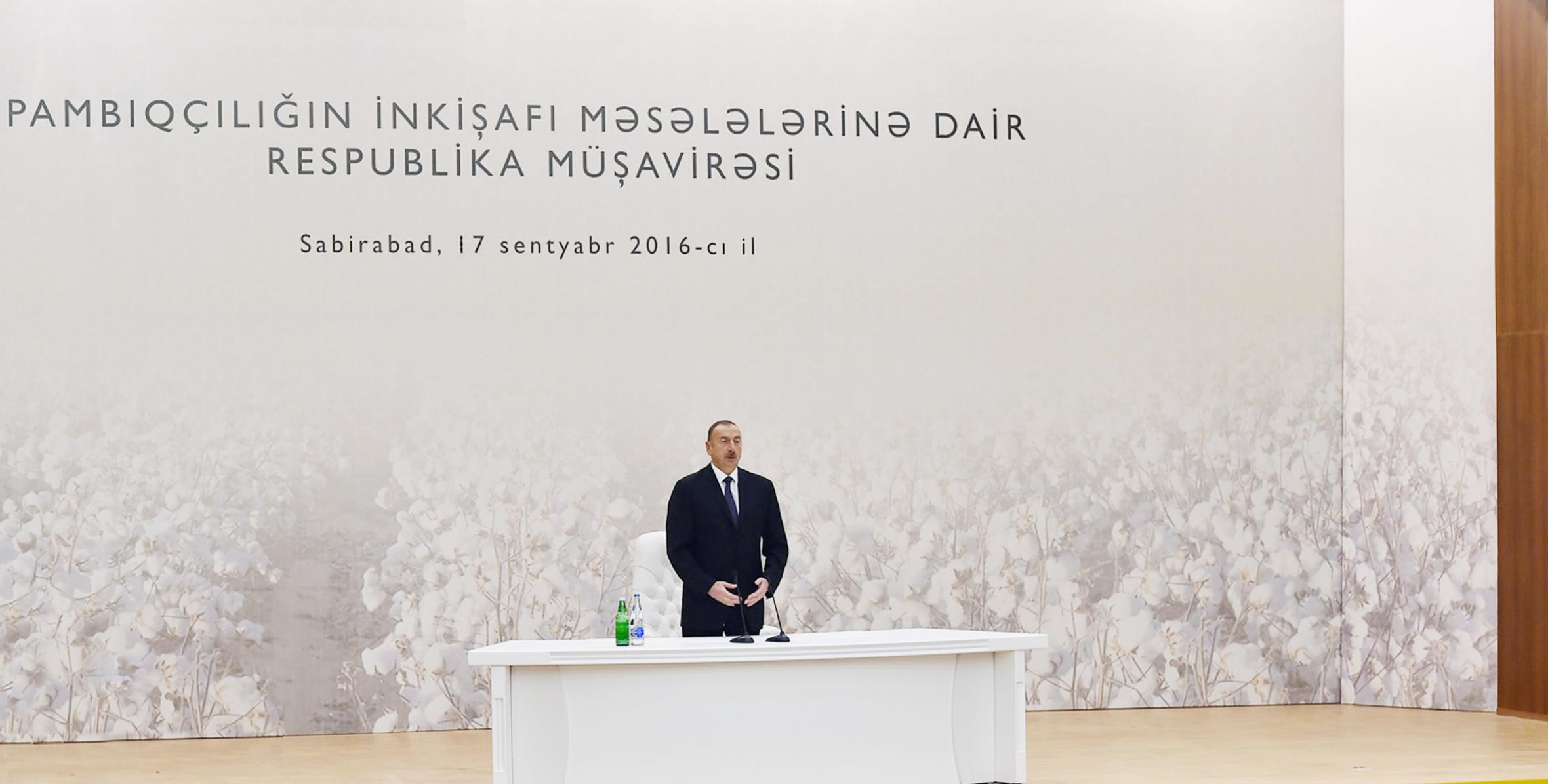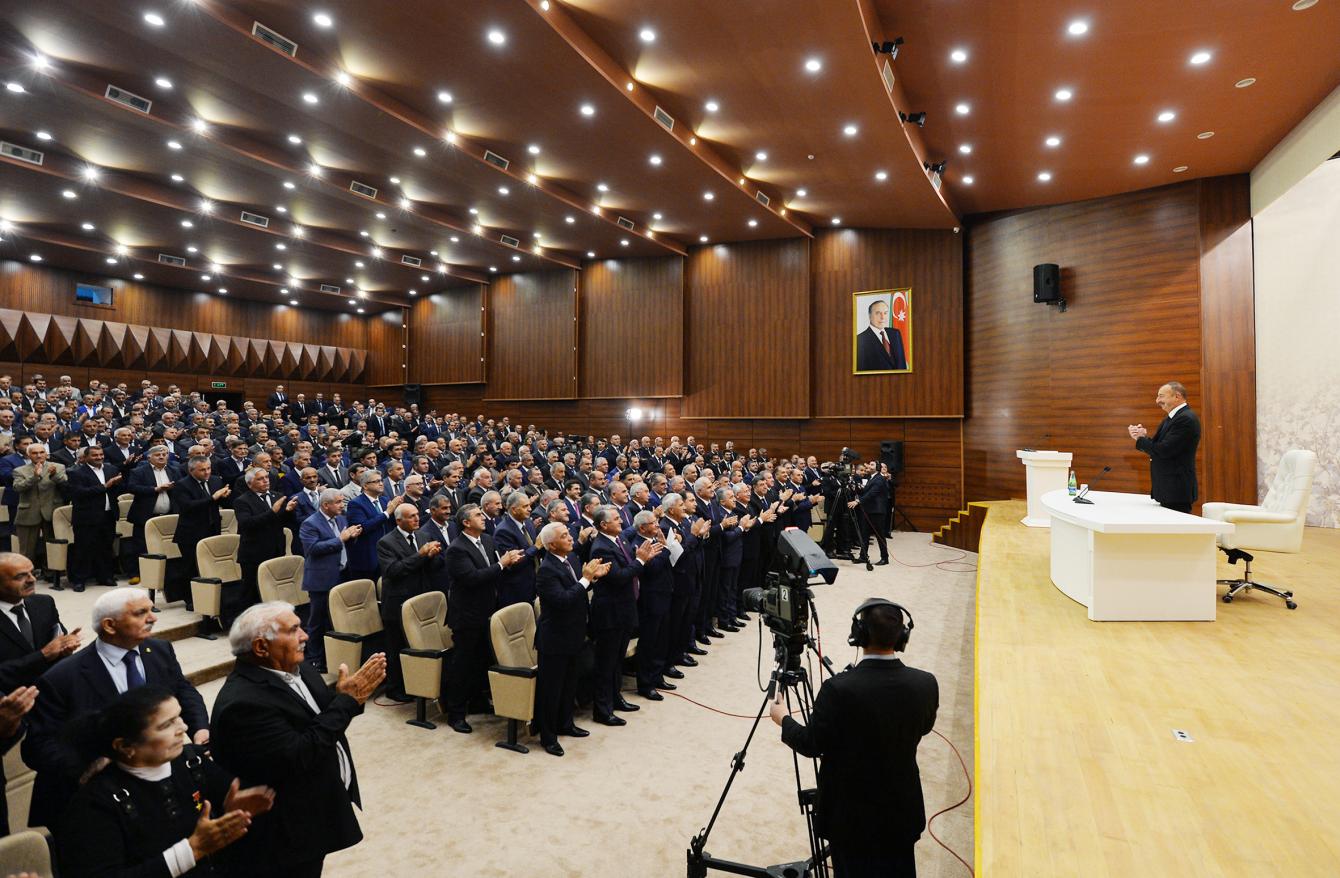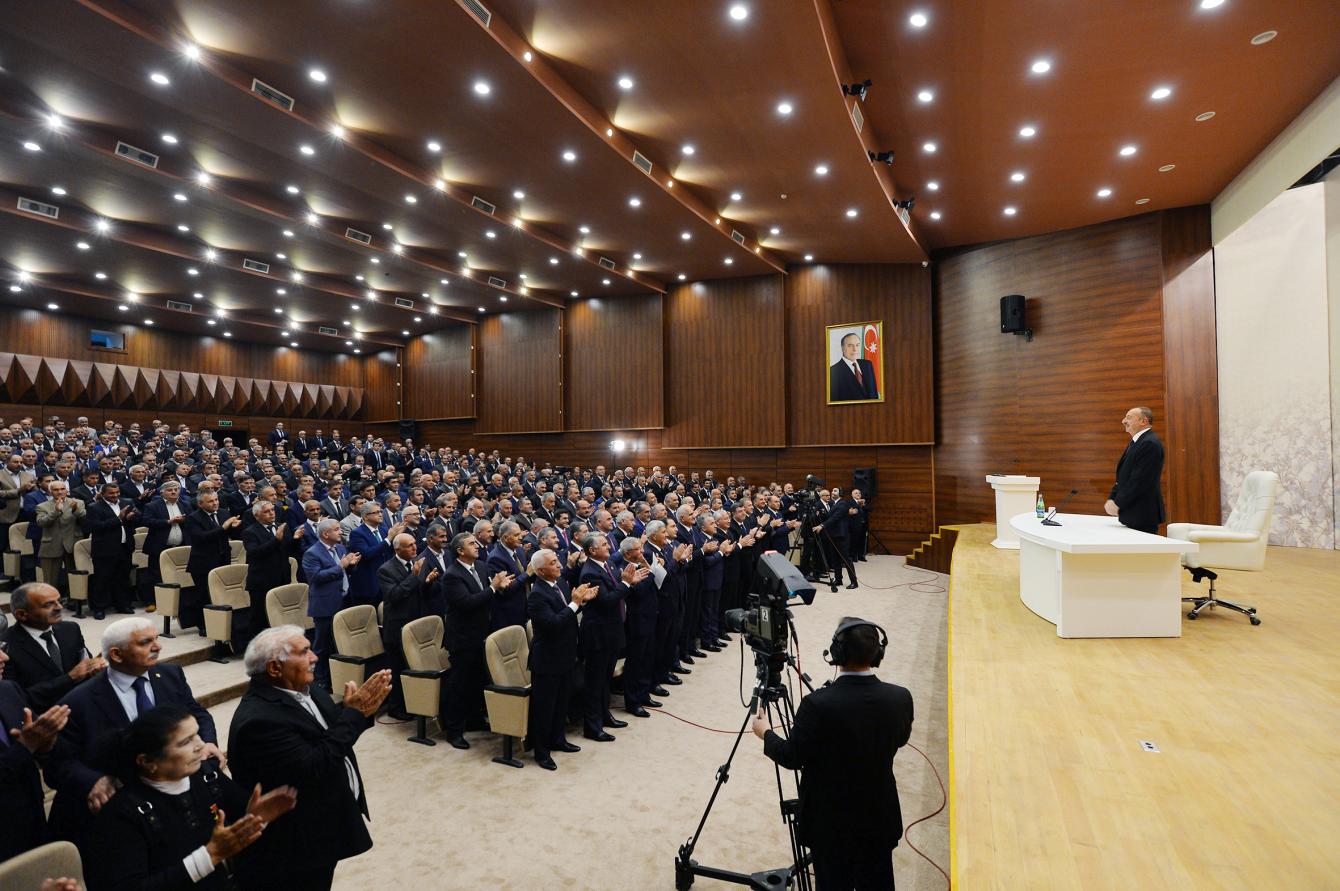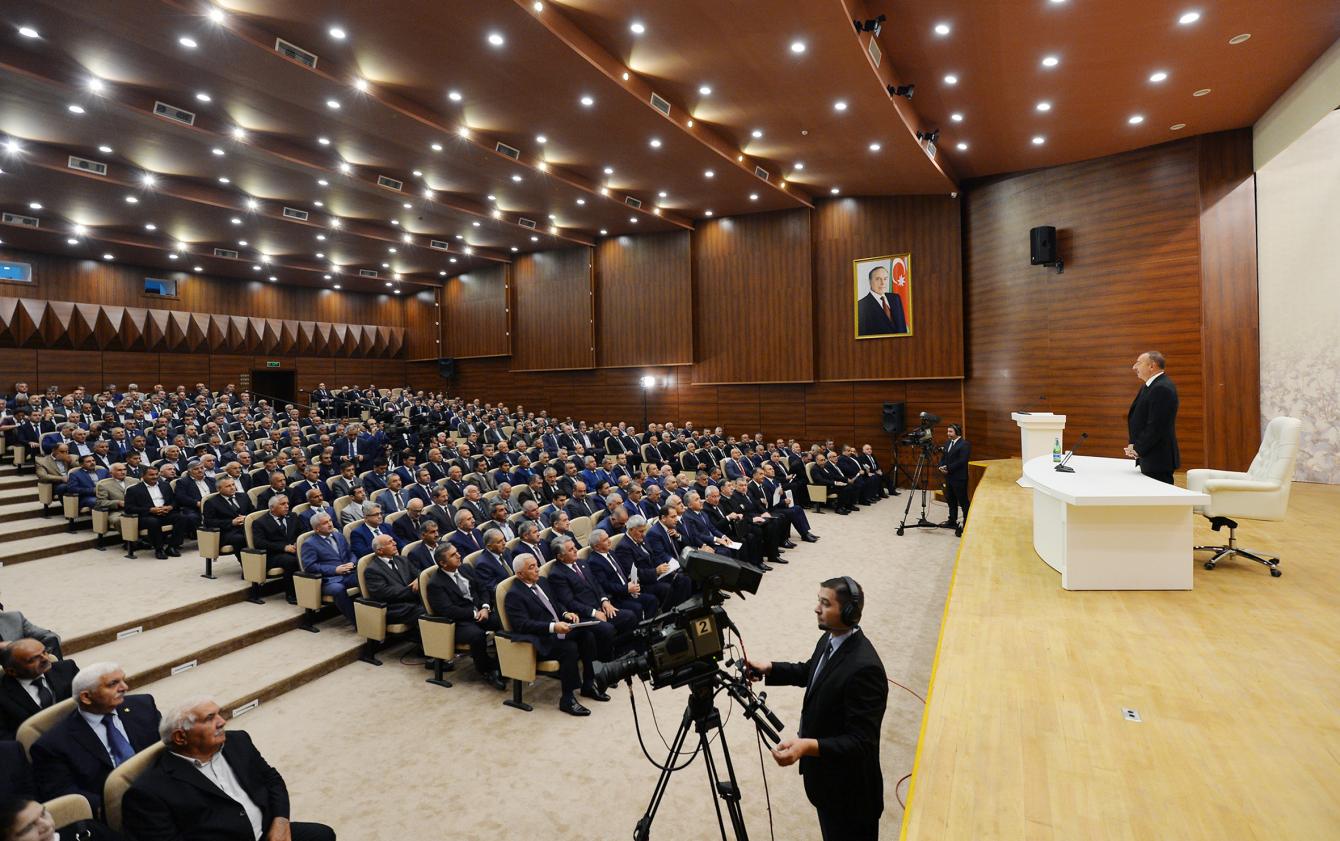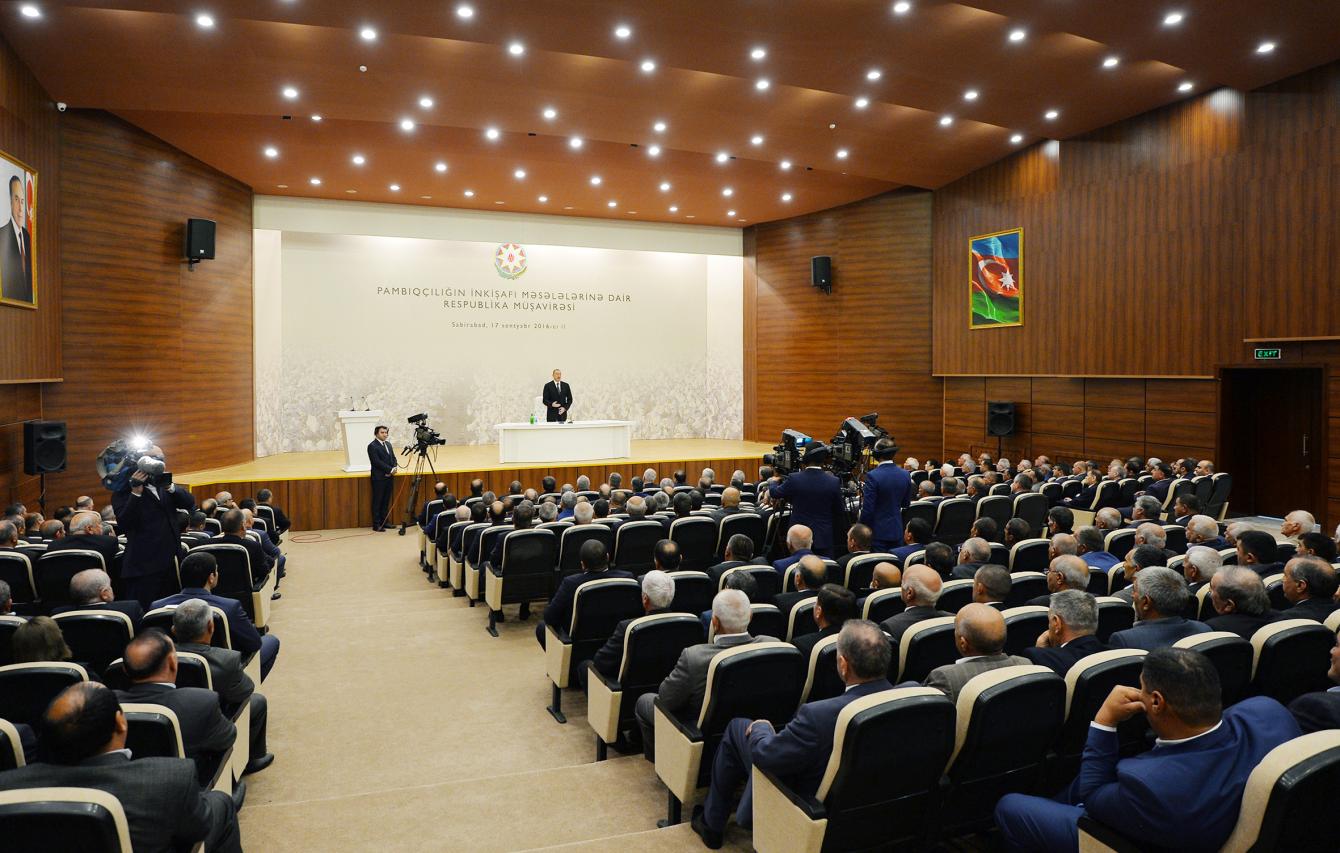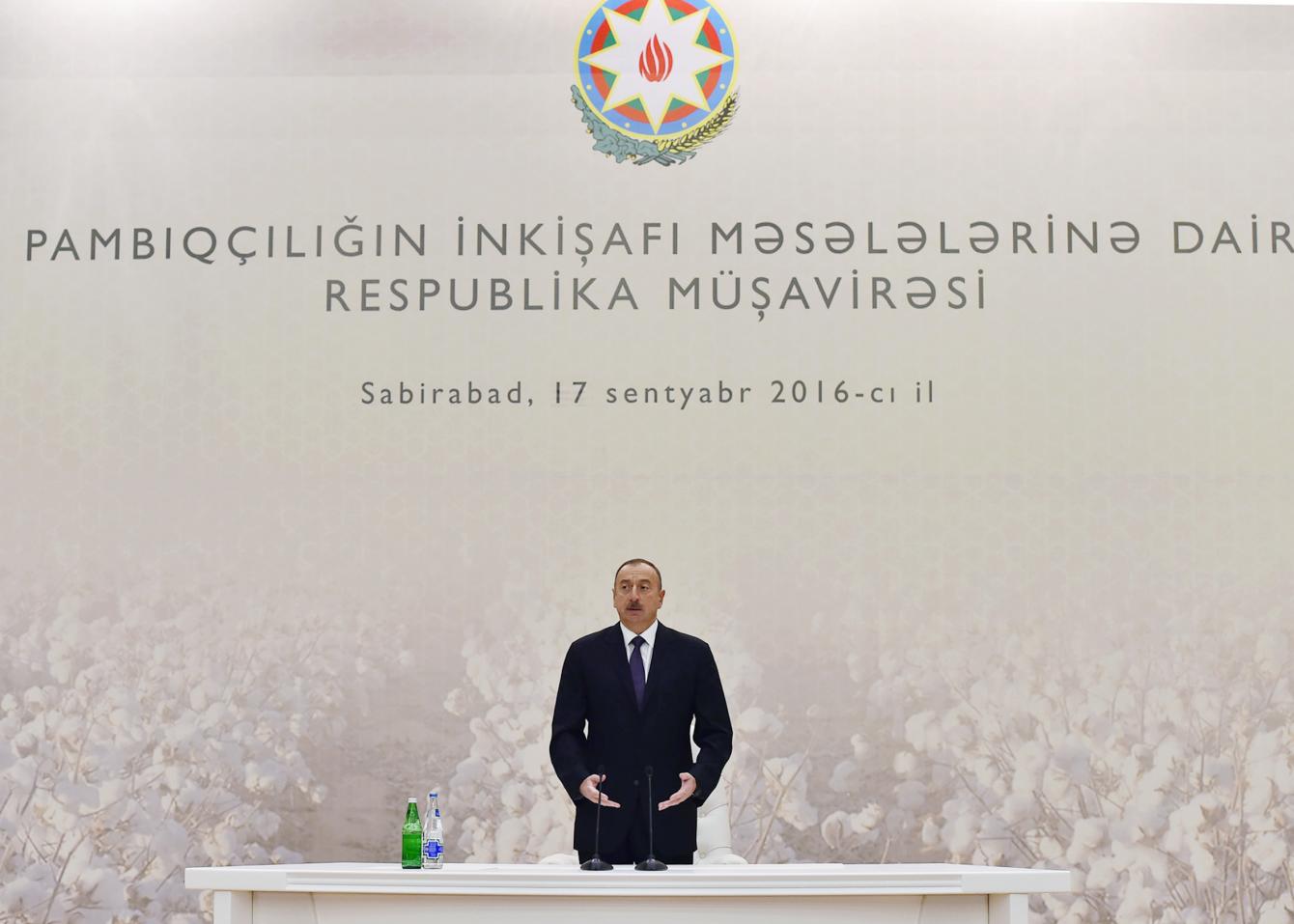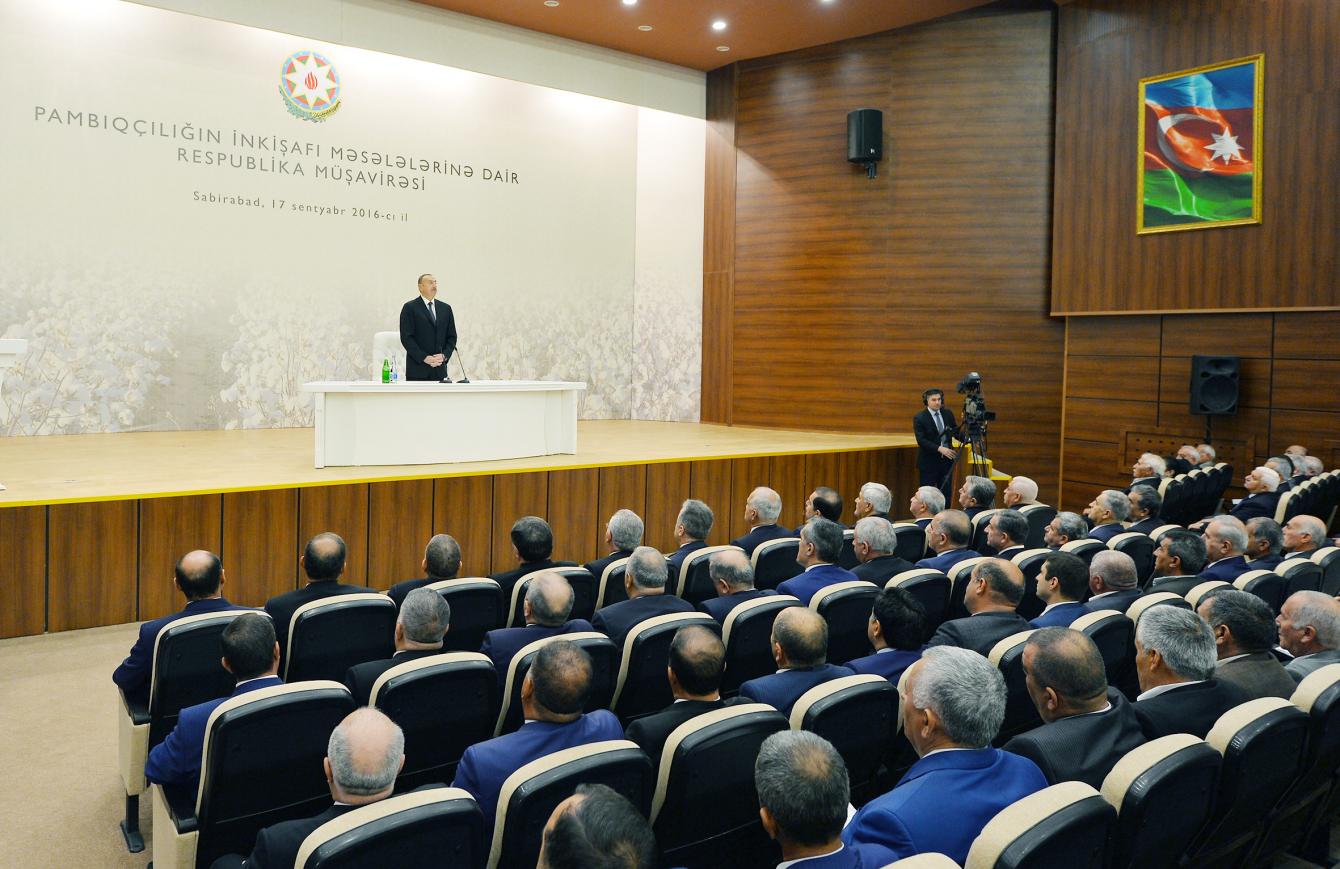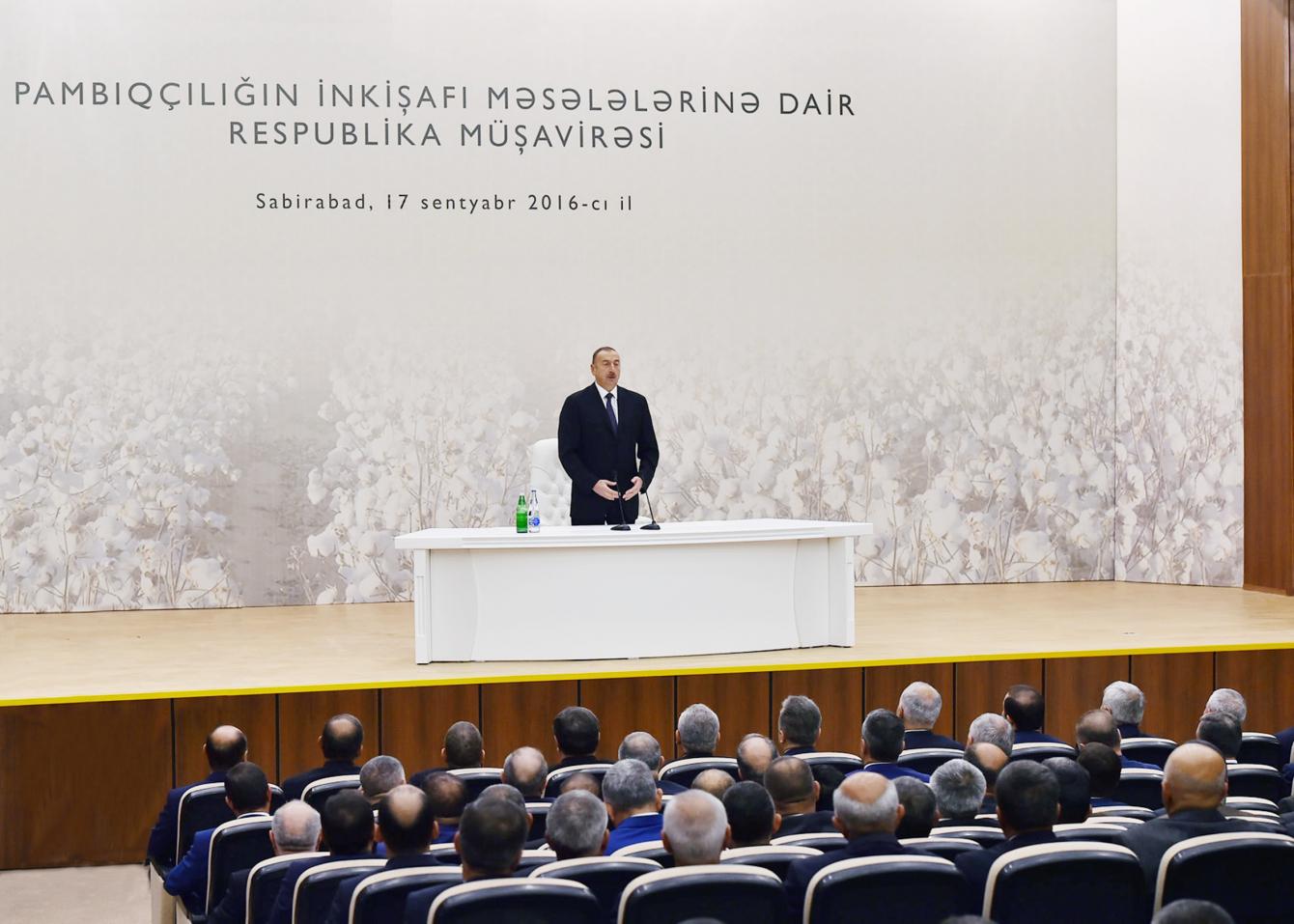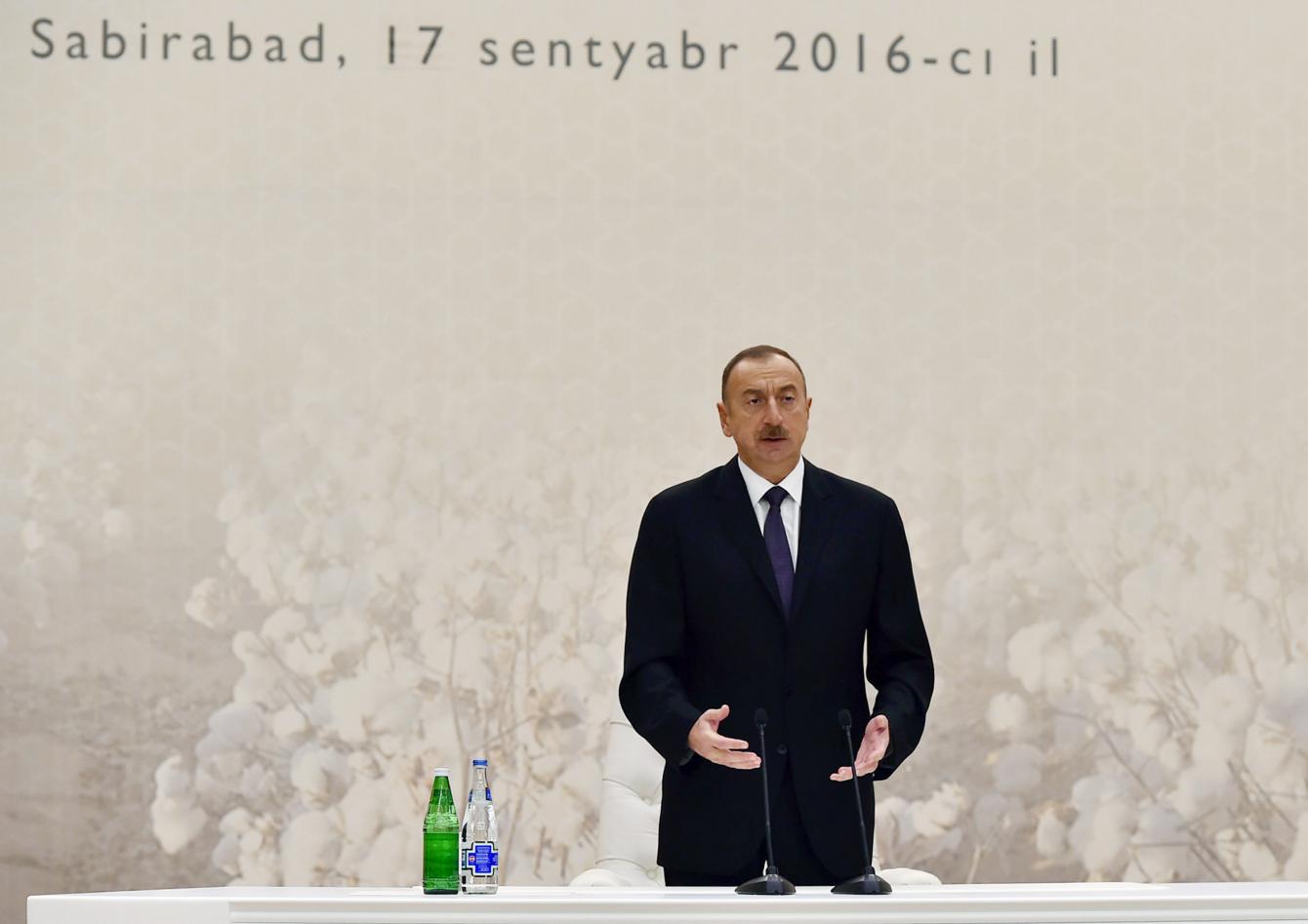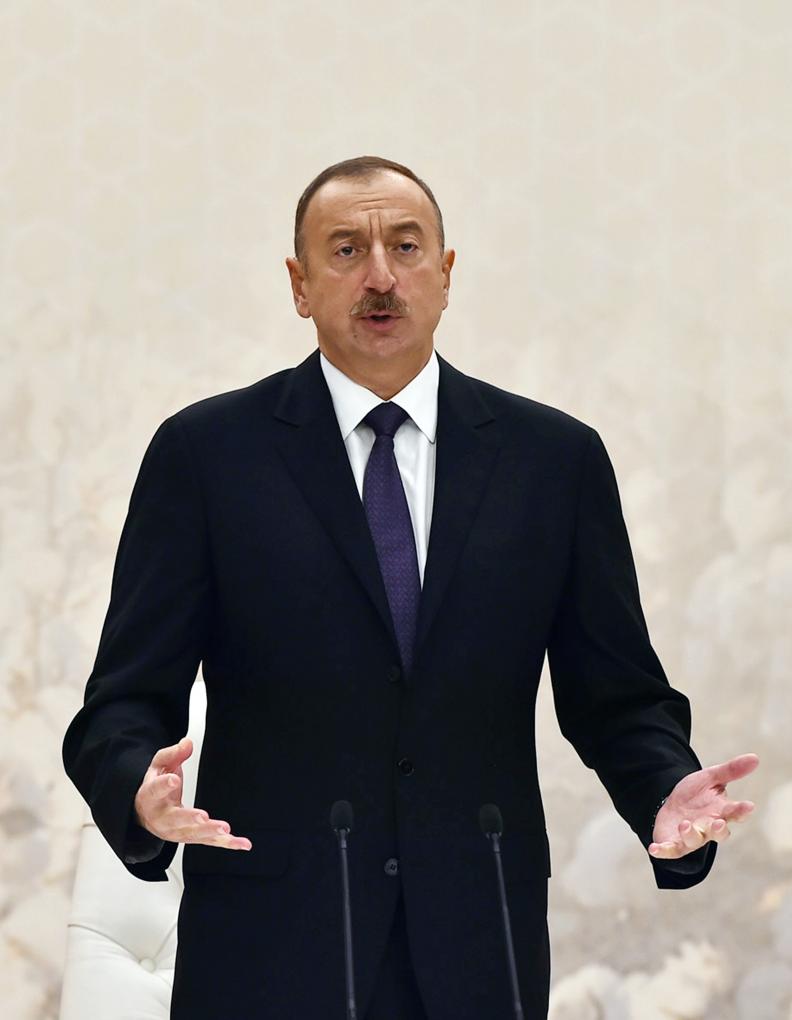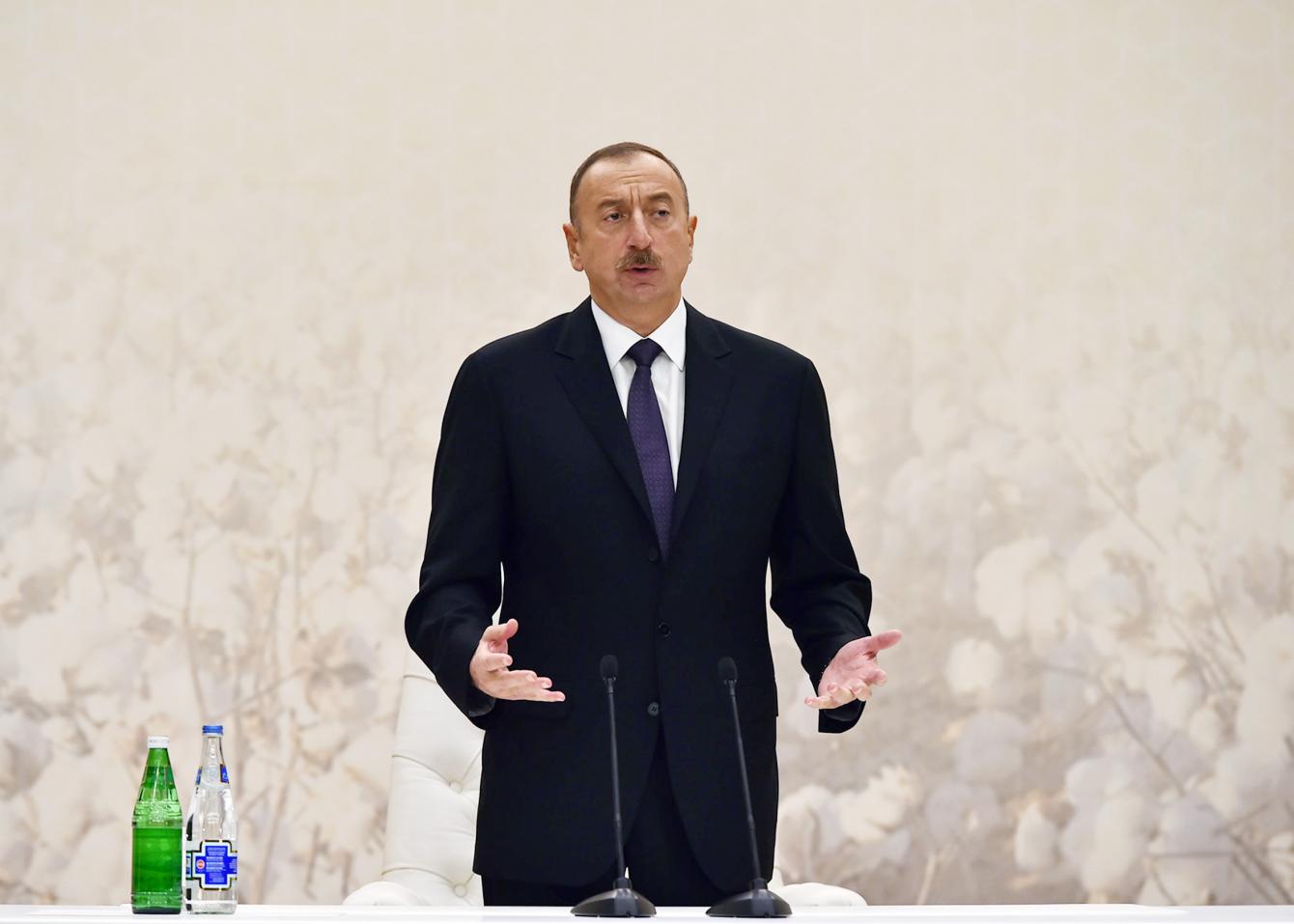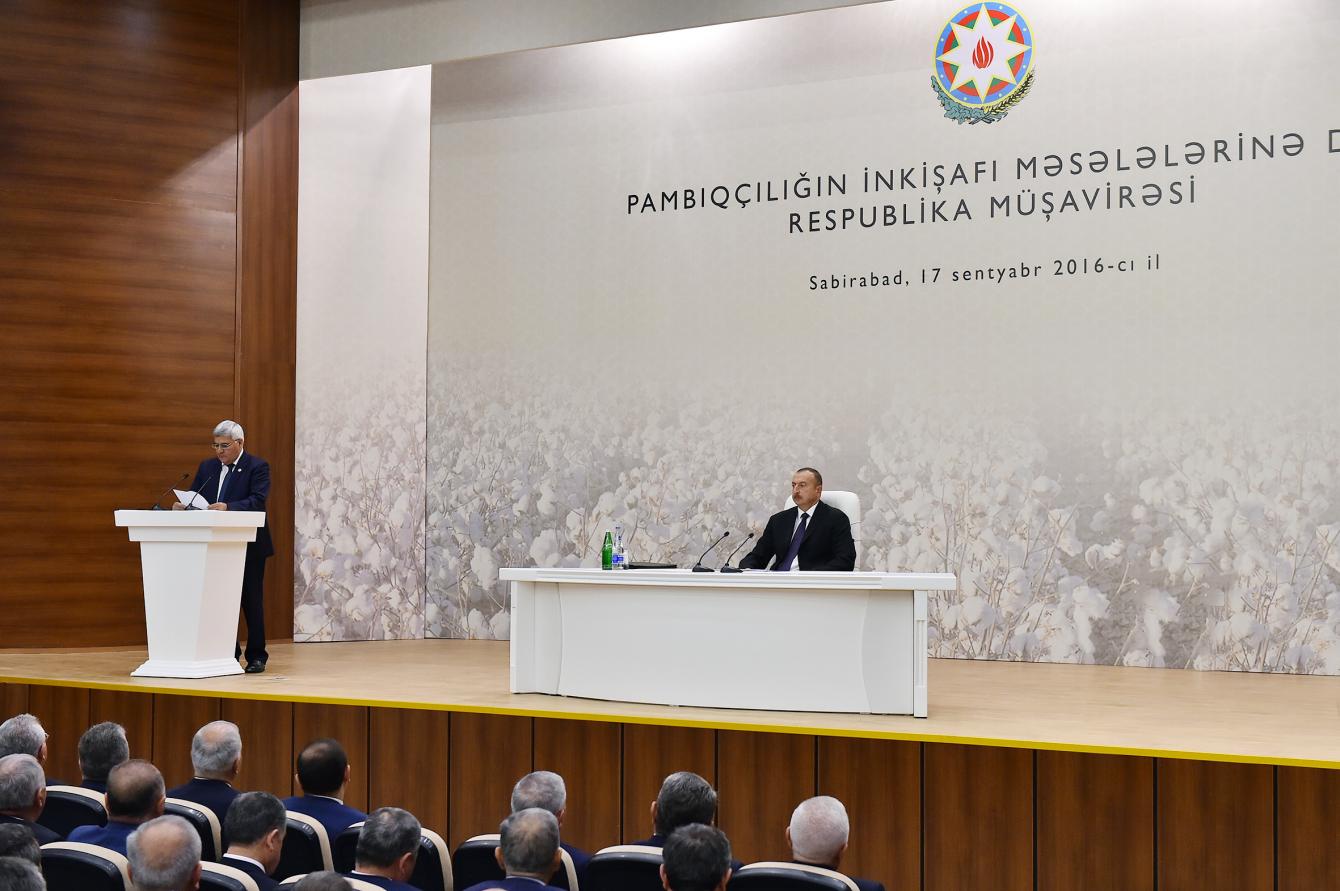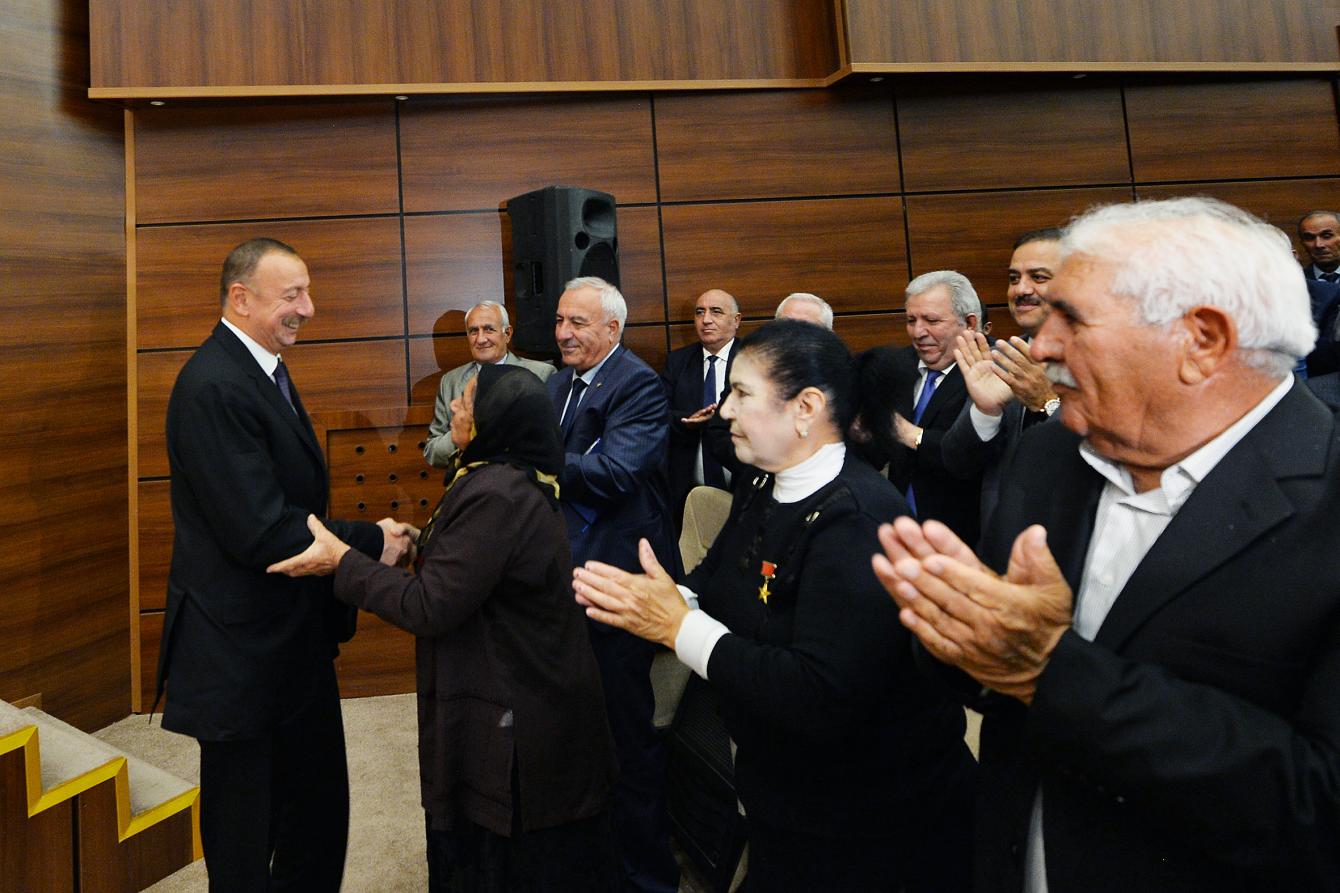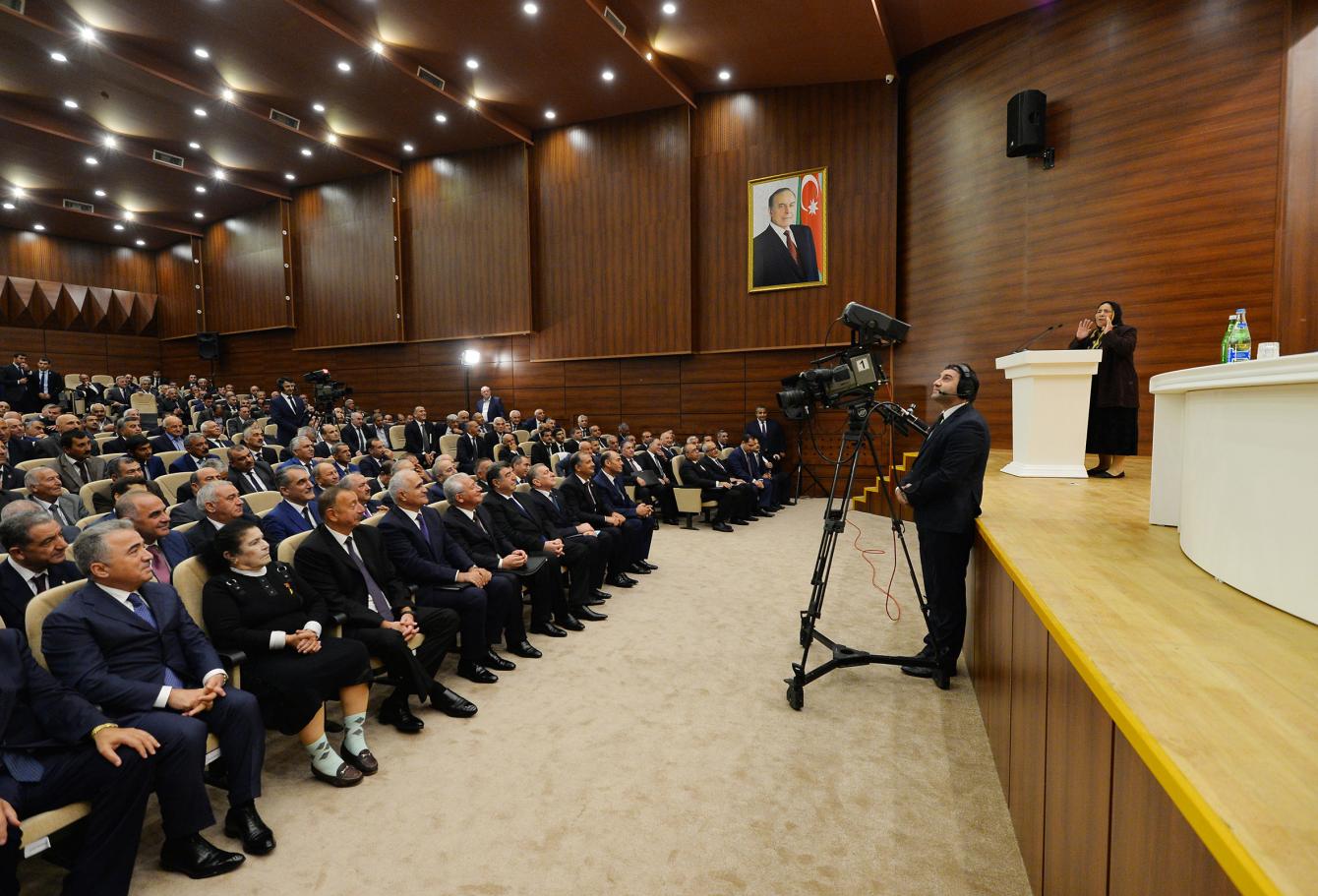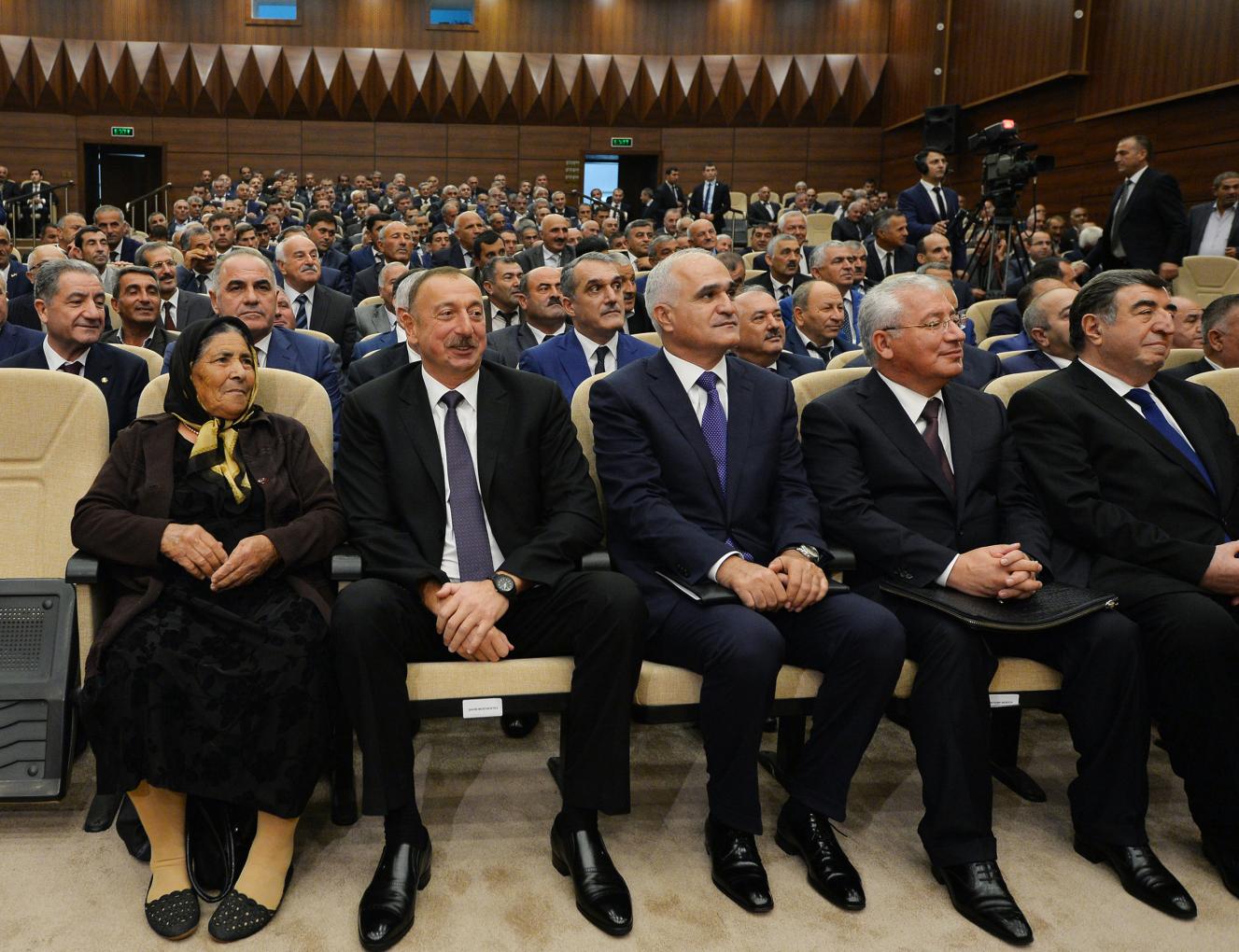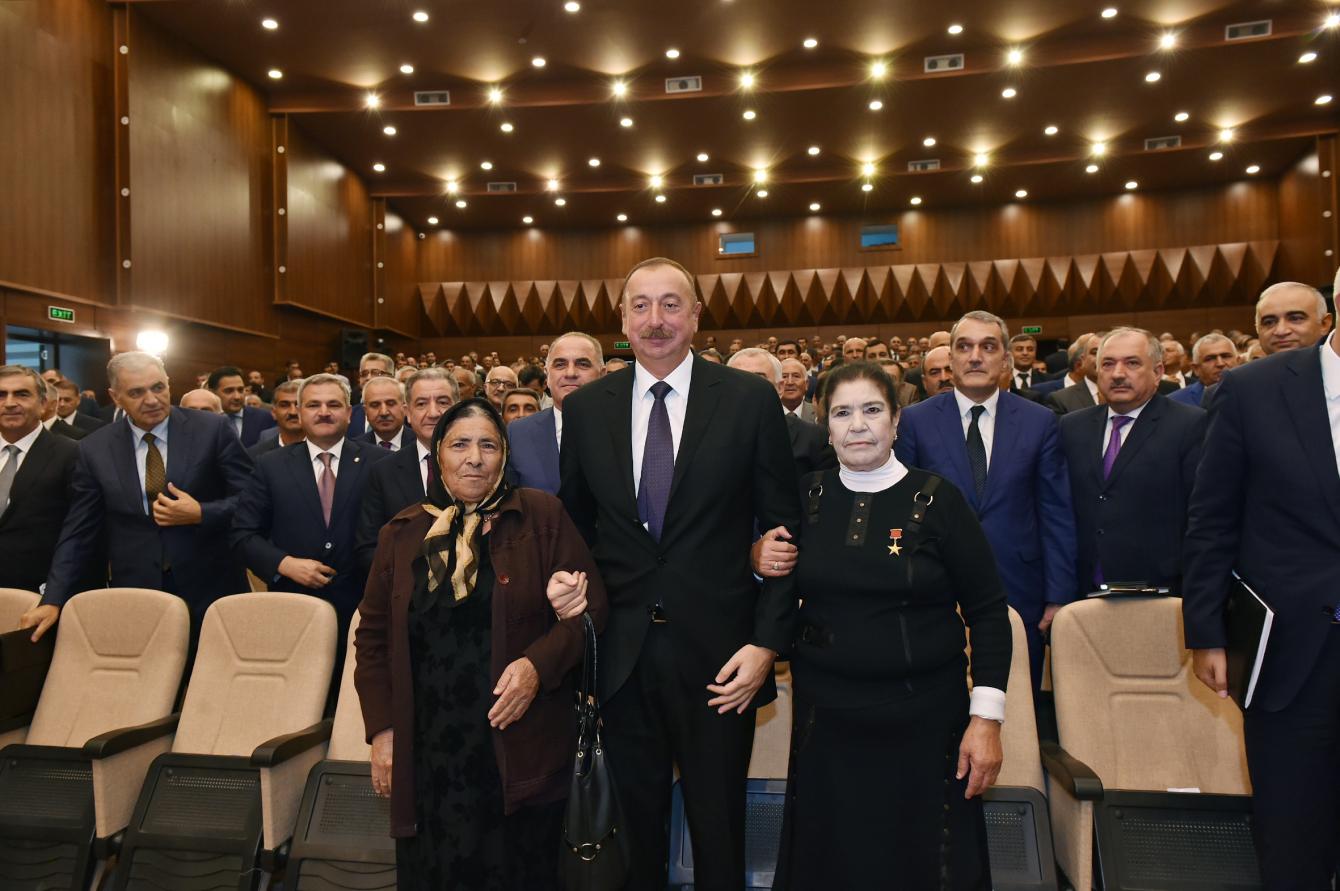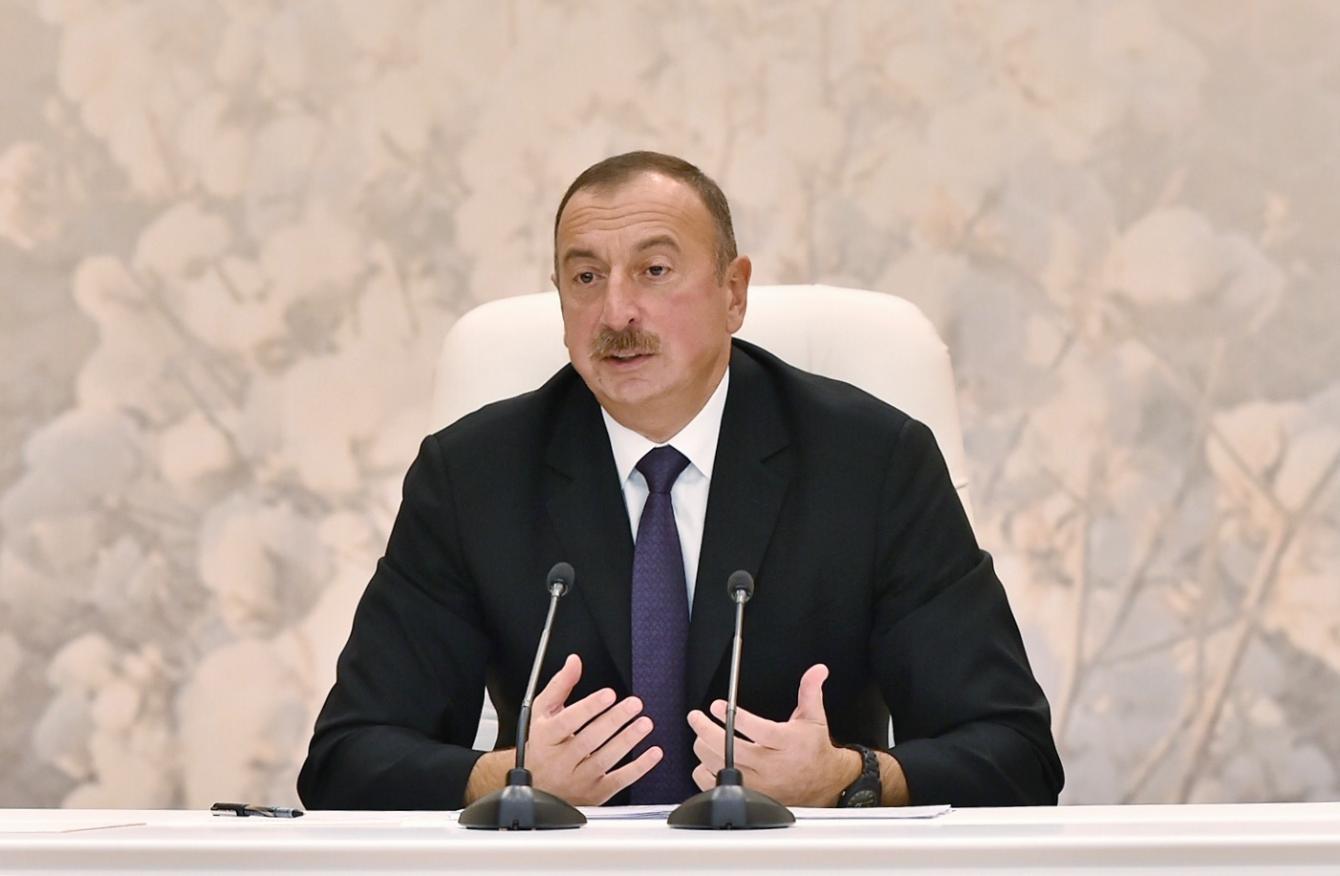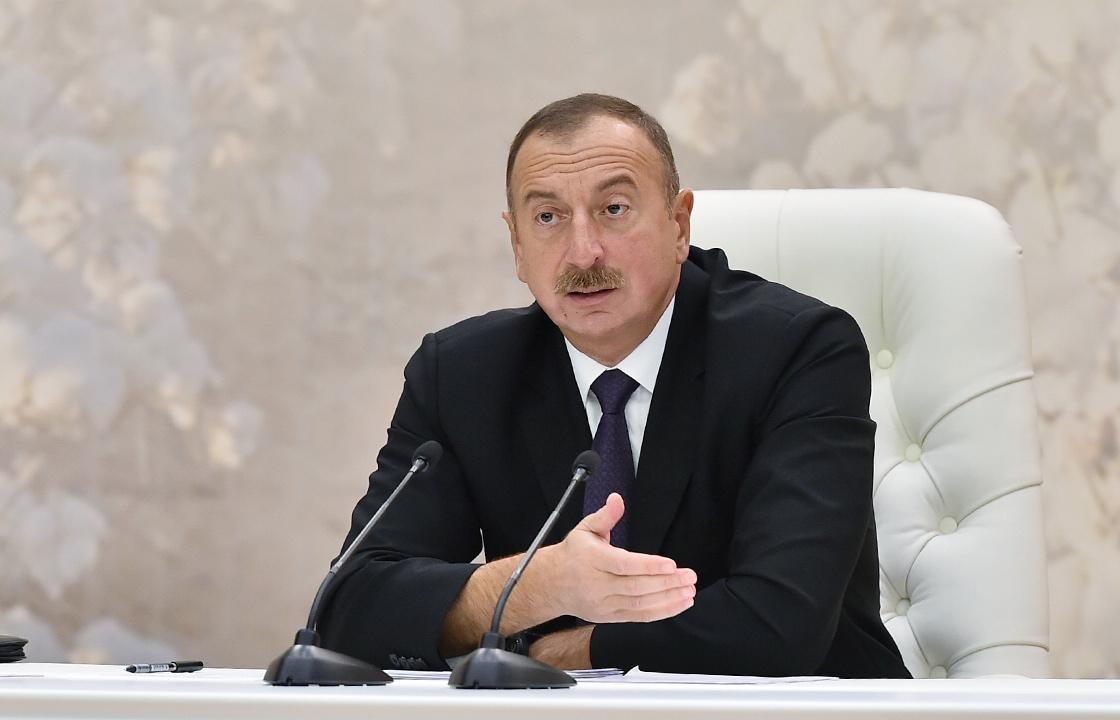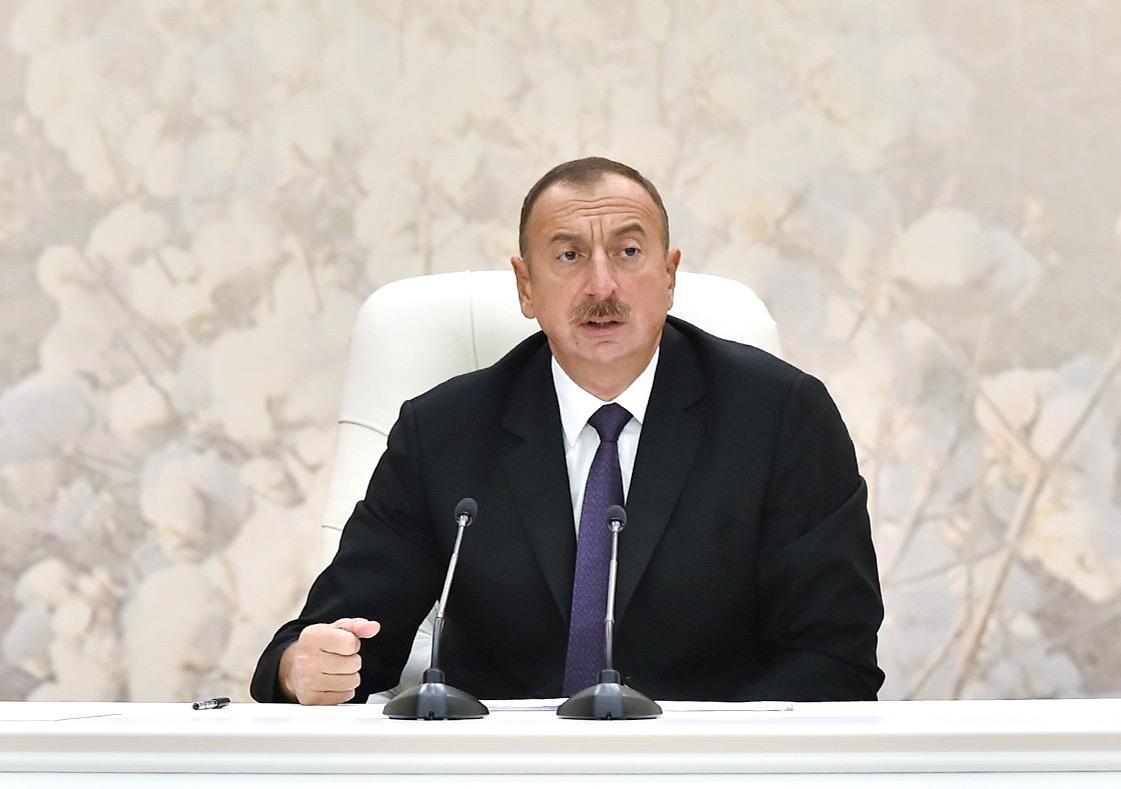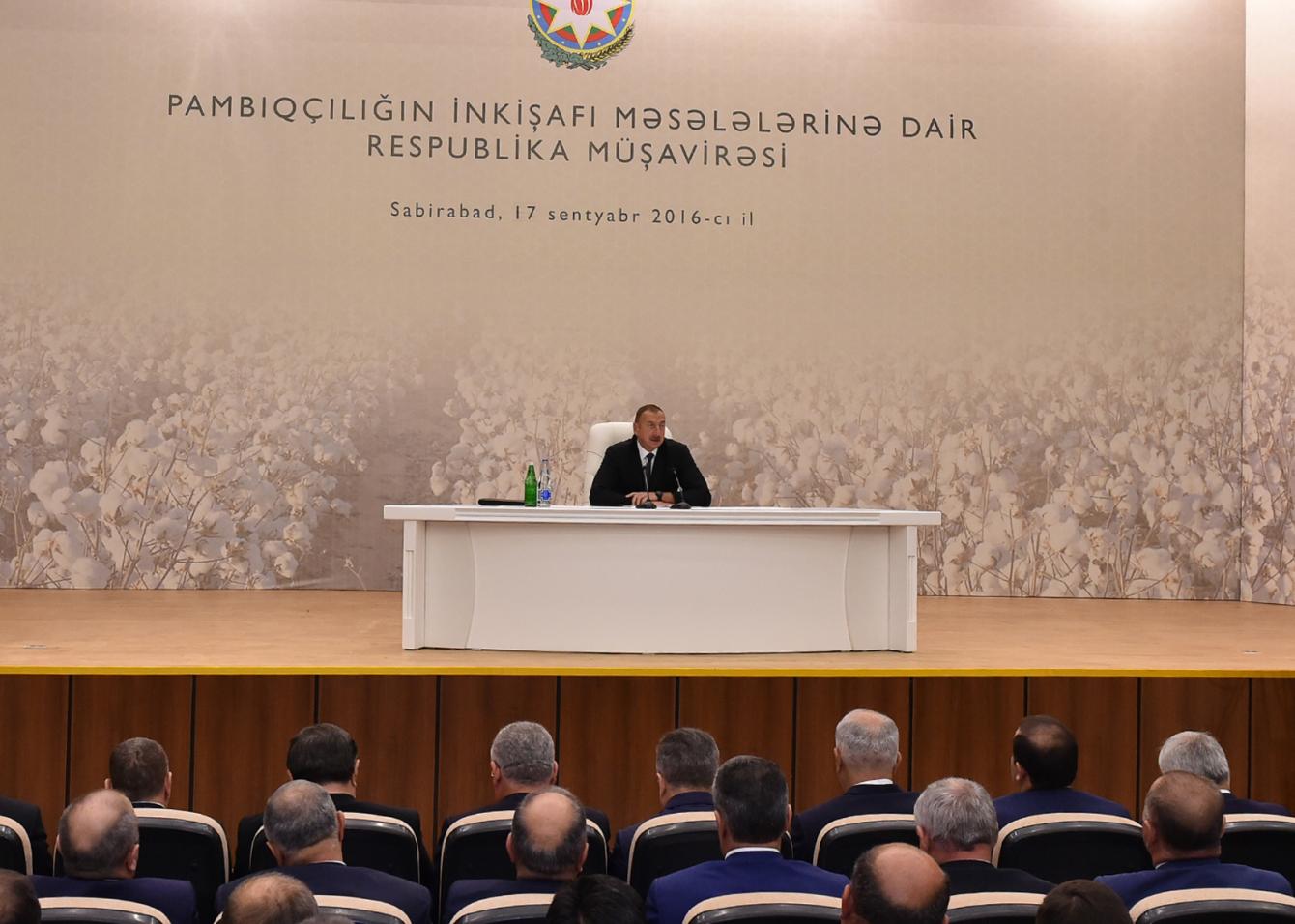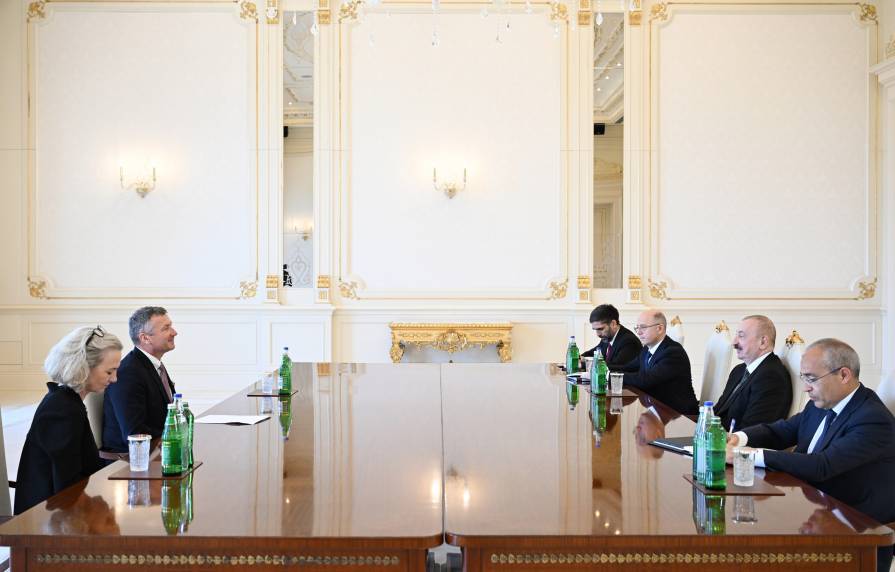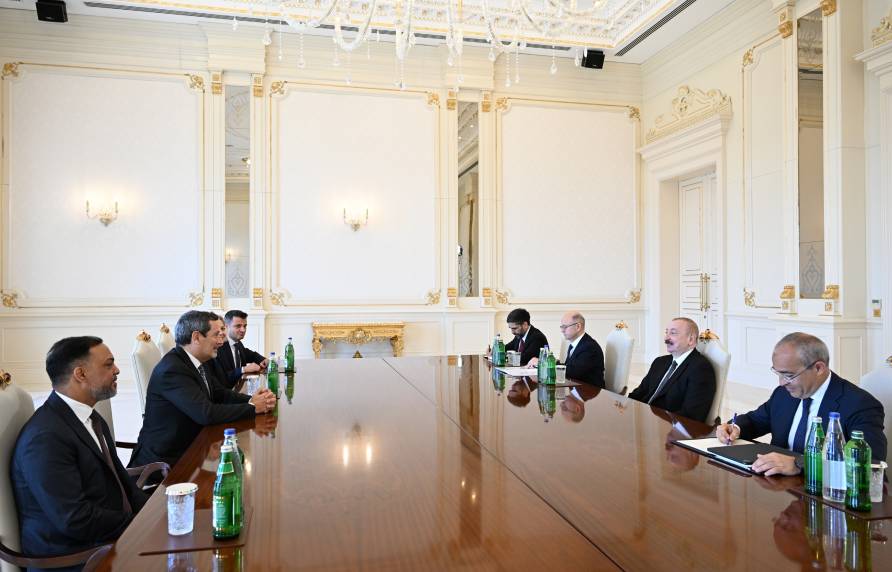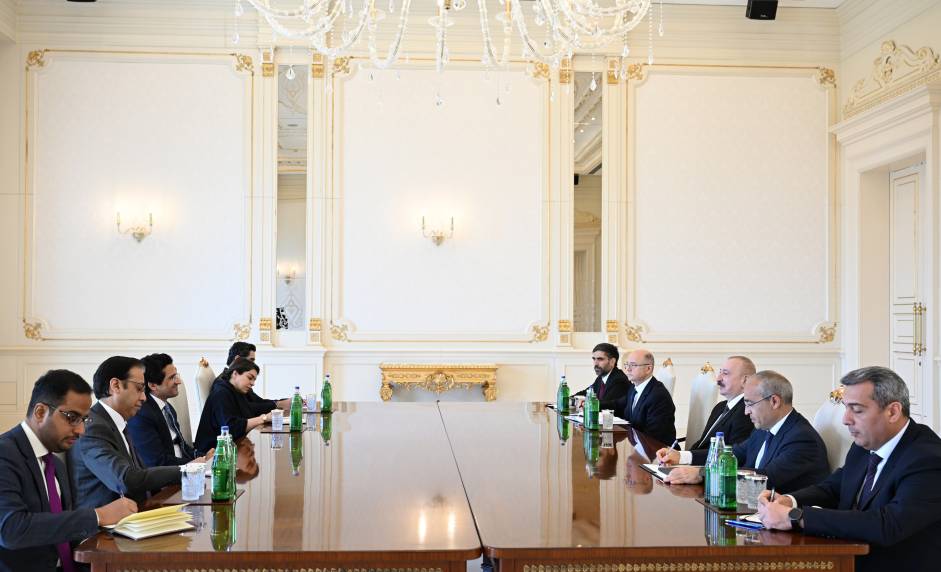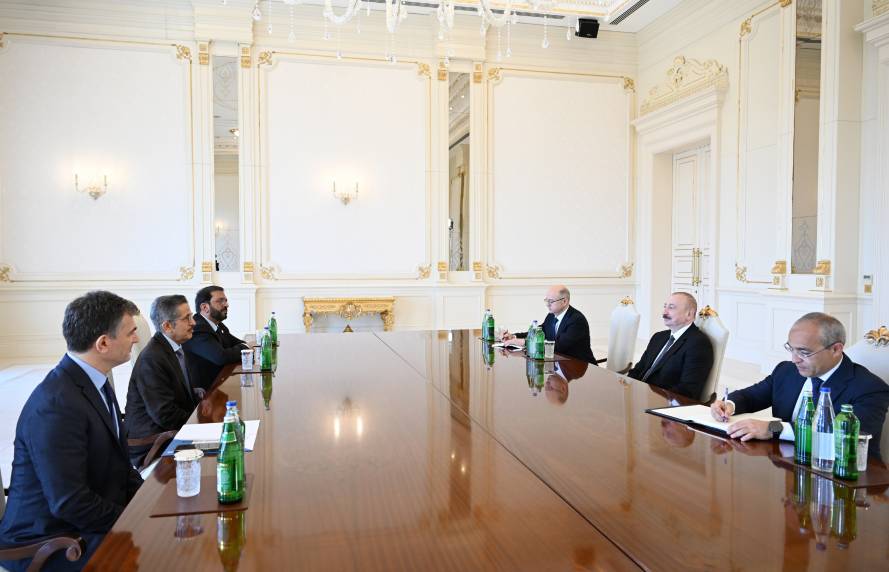A conference on the development of cotton-growing in Azerbaijan has been held under the chairmanship of President Ilham Aliyev in Sabirabad.
The head of state made an opening speech at the conference.
Opening speech of President Ilham Aliyev
- Today's meeting is dedicated to the development of cotton production in the country. The fact that the meeting is being held in Sabirabad District is not accidental. In the 1970s and early 1980s, great leader Heydar Aliyev held annual regional meetings in Sabirabad. Those meetings handed out very valuable instructions related to cotton growing. Staying true to this tradition, I have chosen Sabirabad District as the venue of the first nationwide meeting on the development of cotton production. I am sure that both in Sabirabad and all other districts engaged in cotton production, the restoration of cotton growing will go faster and we will return cotton growing its former glory. This sector brings great incomes both to people and the state.
In the 1970-1980s, the great leader took me along when visiting Sabirabad and other districts engaged in cotton growing. In those years, I was alongside him in Sabirabad and attended those meetings. I was there with him in meetings with cotton growers in cotton fields and camps. So those memories live on in my heart, and it is now even more obvious how far-sighted and attached to the people great leader Heydar Aliyev was. He knew perfectly well that cotton-growing held a very important place in the development of Azerbaijan as a union republic and the well-being of Azerbaijani citizens.
Unfortunately, cotton-growing in Azerbaijan is experiencing a downturn these days. There are certain objective and subjective reasons for that. Today's meeting aims to ensure that we conduct an exchange of views on the work done over the past few months. Some speeches will be made here. We will also talk about the plan of actions for the coming years.
Azerbaijan is experiencing a period of rapid development in various directions. When I was first elected as president in 2003, I said that one of the main directions of my work would be the development of regions. Thus, a few months after the presidential election, in early 2004, the first regional development program was adopted. As part of this program, there were plans to create 600,000 jobs in the country over the course of five years. In five years, by 2008, this goal was achieved.
The development of our regions required major investments, because we first had to create a very strong and modern infrastructure in the regions. Unfortunately, the infrastructure created in the regions in the 1970s was out of order – the roads were in poor condition, power lines were run down, some of them were cut out and sold abroad, there was no gas supply at all, there were huge problems related to water supply, and the development of our regions was pretty much out of the question because the key factors contributing to development require the presence of infrastructure.
This was why we began to implement large-scale infrastructure projects in the regions in 2004. Today, all the regions of Azerbaijan are provided with electricity, gas and drinking water. Whereas in 2003 we imported electricity and gas, now we are exporting them. The power plants built in Azerbaijan in recent years not only provide for our own needs but also create export potential. Similarly, in the field of gas supply, Azerbaijan is becoming a very important gas producing and exporting country of the region, and of the world and Europe in the future.
We are addressing the problems associated with rural roads, including Sabirabad District. This year, we have envisaged more than 200 million manats for that. We can say all the highways are already in good condition. The Baku-Sabirabad highway – I know that this road was causing many problems to the people of Sabirabad – has also been overhauled and commissioned. The implementation of infrastructure projects is essential. Besides, we were faced with a very serious problem of unemployment. The issue has also been resolved. Today, the level of unemployment in Azerbaijan is very low. Anyone interested in working can find a job.
One of our key tasks was food security, because in Soviet times we used to import basic food products to Azerbaijan from other republics. For example, we imported poultry meat, beef, milk, sugar and other staple foods from Russia and Ukraine. So we set the task of ensuring food security. Therefore, Azerbaijan was rapidly developing crop production and livestock breeding. Today, we are fully self-sufficient in terms of meat. We provide ourselves with poultry meat by 100 per cent, milk and dairy products by about 80 per cent. I am sure that in the next two to three years we will fully meet our needs and even export dairy products abroad. Therefore, our main goal was related to these issues, and I can say that we have achieved a lot in addressing food security issues.
But unfortunately, other sectors of agriculture were a little bit away from the spotlight. There are objective and subjective reasons for that. It was believed that we live in a market economy, which regulates and establishes everything. But experience shows that this is not exactly the case. Of course, we are committed to the market economy, more than 80 per cent of our economy is formed in the private sector and a lot of support is being paid to the development of private enterprise, including major financial support. In recent years, entrepreneurs have been provided with favorable loans worth more than 1 billion manats for the implementation of various projects. However, the decline in cotton production shows that the state should certainly intervene in these matters. The market economy does not necessarily mean that everything will go as it should. The decline in cotton production is a good example of this. It was therefore decided that since the vast majority of issues related to food production and food security have been resolved and the projects being implemented will bear fruit in the near future, the state should provide more support for agricultural development and have greater involvement in this area. Involvement in the sense that we need to help farmers resolve their problems, restore and develop traditional industries in our country, which, unfortunately, are experiencing a recession.
So I believe that this year has been a watershed in this area. Let me go back to Soviet times again. At that time, there was a division of the national economy. Some republics developed livestock breeding and grain production. In Azerbaijan, as I said, we developed viticulture, cotton, tobacco, tea growing, silkworm breeding and other industries. After the collapse of the Soviet Union, the communication between republics was disrupted and we were faced with a difficult situation. Today, we are restoring our traditional agricultural sectors, and 2016 should be a turning point in that direction.
There has been extensive development in sericulture this year. Whereas in 2015 only 200 kilograms of raw cocoons were produced, this year the figure has reached 70 tons. As a result of the measures taken, Azerbaijan will harvest 1,000 tons of cocoons in a few years. Look how much income tens of thousands of people will make.
Serious steps have been taken in tobacco growing this year. We intend to double tobacco harvesting.
The measures taken in previous years in connection with viticulture are bearing fruit. However, I still think that it is not up to standard and we should invest more.
In order to increase the production of exportable products, large hazelnut gardens will be set up in different regions. We will create gardens covering an area twice as big as current hazelnut plantations. Places have already been identified. The irrationally used lands will be systematically sown.
We now have large pastures. People engaged in agriculture will know that there are standards as to how many heads of livestock should be raised per hectare. These standards are also violated. A very serious state livestock program is being implemented and tens of thousands of heads of pedigree cattle are imported. We are now switching to the system of artificial insemination, so within three to four years the breed of cattle in Azerbaijan will be completely changed. We will ensure high productivity of both meat and dairy cattle breeds. To this end, we are implementing projects to raise cattle in enclosed areas.
Extensive lands will be included in the turnover in a more rational manner. Therefore, a serious audit is being conducted this year. Some lands have been illegally seized by different people and nothing is being done on these lands. Lease agreements for these lands should be terminated. Many lease agreements have already been terminated and this process continues. There should be rigorous oversight on the part of state bodies, local authorities and the public. I have repeatedly said that there should be strong public oversight in Azerbaijan. If public oversight, i.e. oversight by citizens, is strong, then we will be able to address these challenges even more successfully.
Today, the country’s priority is the production of export-oriented products, and this goal must be met. What is the reason? First, we need to do this to completely use the entire agricultural potential of the country. No patch of land should remain vacant. This will increase productivity and bring an income to even more people. The state will also benefit from that.
Agricultural development is a priority area in Azerbaijan. Today, farmers are exempted from all taxes except for the land tax. Major subsidies are paid. Farmers are provided with funds amounting to 200 million manats in the form of subsidies. Agricultural machinery, fertilizer and fuel are acquired and given to farmers on easy terms. There should also be serious political and social oversight. At the same time, local executive authorities should be more active in this, so that the funds allocated by the state reach their destination and there is a result. We are now analyzing the issues related to subsidies and preparing new proposals.
In addition, as you know, due to the fall in the world oil prices, our revenues have declined. If prices fall three- to fourfold, then so do the revenues. We need to ensure the inflow of currency to Azerbaijan. Therefore, the production of exportable goods is of special importance. Cotton is also an exportable product. It is not by chance that it is called "white gold". This is the first year in the reconstruction of cotton. If we look at the statistics now, we can see a miserable picture. Thanks to the tireless efforts of the great leader and the great dedication of the workers in the 1970-1980s, Azerbaijan harvested a million tons of cotton, while now the figure is only 35,000 tons. In those years cotton was seeded on an area of 300,000 hectares, while last year it was planted only on 18,000 hectares. What does this mean?! This means a destruction of cotton production. This is intolerable and we have to take serious measures. This year we are a little late, but still some good results are already expected this year. Those representing districts here today will talk about this in their speeches. This year, on the whole, cotton was sown on an area of 51,000 hectares. This is about three times more than last year.
Whereas 35,000 tons of cotton were picked last year, this year we should pick at least 100,000 tons. We have even bigger plans for next year. Preparations for next year have already begun. This year, we have spent a lot of money on this. All the necessary measures have been taken in good time. Measures have been taken related to irrigation and electricity. We have imported new cotton harvesters and agricultural machinery of hundreds of denominations. Some of the machinery is still on its way. It will be delivered next month and will continue to be delivered in 2017 as well.
Today, when the world is gripped by an economic recession, our revenues have decreased three- to fourfold. Despite this, we are still spending hundreds of millions of dollars to purchase agricultural machinery and give it to farmers on favorable terms, so that they could earn money and the state could benefit from that.
Development of cotton growing, along with the solution of economic issues, is also a social issue, because, according to my information, about 70,000 people will work on cotton fields of 24 districts this year, which means an increase in employment. Over the past 13 years, we have created 1.3 million jobs in the country. This is a historic achievement. We have taken very serious steps to eliminate unemployment. But this should be an ongoing process. Why? Because unlike some other countries, the demographic situation in Azerbaijan is very positive! And this is due to our economic development. Our population is growing. Whereas in the 1970s our population was about 7 million people, today it is closer to 10 million. In those years, we engaged students in the harvesting of cotton, which is no longer necessary today, because we have sufficient manpower. Therefore, the development of cotton production means new jobs. I believe that next year cotton acreage should be even greater, which will also increase the number of people employed. Hundreds of thousands of people will be attracted to this work in cotton growing districts. This year, we have increased the purchasing price of cotton by 20 per cent. However, we should see if we raise it again. Today, on the way here, I visited the team of the famous cotton-grower and Hero of Socialist Labor, Fatma Huseynova. She had a tea table laid out for me – I want to thank her for that. We shared some pleasant memories. So let’s greet Fatma Huseynova. During the conversation, it was noted that although the purchasing price has been raised, it would be good if it was increased a little more. Of course, it would be good. We also want this, as it would be better for the workers. So I am asking relevant bodies – the Presidential Administration, the ministries of agriculture and economy, the companies dealing with cotton: we must increase the purchasing price as far as possible. First of all, we should do that for the people to make more money. At the same time, we should take additional measures to stimulate the development of cotton growing. This year, in a short time, in a matter of a few months, we used administrative methods and did a great job of quickly resolving the problems associated with the deployment of equipment, irrigation and electricity. But we need to try to engage peasants themselves. In this case, we will get more yield, of course.
Of course, there are also issues related to productivity on our agenda. In contrast to the 1970s, there are more modern technologies in the world today, which we are importing to Azerbaijan in order to increase productivity. Whereas last year the yield per hectare was 20 quintals, I believe that as a result of the measures taken, we will be able to increase this figure to about 30-35, perhaps even to 40 quintals. You know yourselves what this would mean. I want to emphasize the work of the Presidential Administration in this area. Despite time constraints, it was thanks to the efforts of the Presidential Administration and heads of local executive authorities that we have achieved such a turnaround this year. The heads of executive authorities, activists and workers – everybody worked hard.
I want to say again: 2016 will be a crucial year for the development of cotton growing. This is only a beginning, and I am sure that from now on cotton production in Azerbaijan will grow rapidly. As I said, it will bring great benefits to both people and the state.
Let’s now move on to discussions.
X X X
Head of Sabirabad District Executive Authority Nazim Ismayilov, Head of Agjabadi District Executive Authority Shahin Mammadov, Deputy Director General “MKT Istehsalat Kommersiya” LLC Bahruz Jamalov, Head of Saatli District Executive Authority Siragaddin Jabbarov, Head of Imishli District Executive Authority Vilyam Hajiyev, Acting Director General “CTS Agro” LLC Arif Ibrahimov, Head of Barda District Executive Authority Vidadi Isayev, Head of Bilasuvar District Executive Authority Mahir Guliyev addressed the event.
X X X
President Ilham Aliyev made closing remarks at the conference.
Closing speech of President Ilham Aliyev
- Heads of Executive Authorities of six districts made speeches at today’s meeting. These are the largest cotton-growing districts. Representatives of the two companies also made remarks. The reports made provided sufficient information about the work done. I think that it is commendable and we should continue it. Now the main stage of harvesting begins. During the harvesting, we should take all the necessary measures. I will express my opinions and issue the necessary instructions today. But first I would like to inform you about some statistics.
In 1969, when great leader Heydar Aliyev was elected leader of Azerbaijan, cotton production in the country amounted to 300,000 tons, while in 1981 it reached 1,015,000 tons. So over 10 years, cotton production more than tripled. After Heydar Aliyev left for Moscow, cotton production and indeed all spheres in Azerbaijan started to experience a recession, and this is reflected in the statistics. In 1985, cotton production in Azerbaijan dropped from 1 million to 780,000 tons. Subsequently, the decline was even faster. As I mentioned, as a result we picked only 35,000 tons of cotton last year, which is the lowest indicator.
As a result of the measures taken this year, we expect to prepare at least 100,000 tons of cotton, if productivity is around 20 quintals. The speeches made here cited other figures as well. In some places we can get 20 quintals, in others more. Therefore, these figures are, of course, rather conditional. At the end of the season we will get a complete picture of these issues.
We expect to produce even more next year if the yield is 20 quintals. I believe think that it should be higher. Next year we will grow more than 200,000 tons of cotton. I do not want to voice any figures. I do not want to give any specific instructions either. Life will show. But we need to know the sequence of cotton production sequence. I believe that in 2017, if all the orders are executed as they should, we can get 250,000 and even 300,000 tons of cotton.
The figures related to cotton yield show everything themselves. In 1970, the yield per hectare was 17 quintals and in 1981 about 36 quintals. Today it is 18.8 quintals. Quite interesting is the statistics on the share of cotton in the overall structure of areas under crop. In particular, this share was 16 per cent in 1970, 22 per cent in 1982 and 1.2 per cent in 2015. When I say that the cotton in Azerbaijan is declining, this is what I mean.
In 1970, cotton was sown in Azerbaijan on an area of 190,000 hectares, while in 1982 on an area of 305,000 hectares. Last year, this figure dropped to its lowest – 18,700 hectares. This year we sowed it on 52,000 hectares. The goal for next year is 128,000 hectares. If we take the current level, then, as I have already noted, the sowing of cotton on 128,000 hectares of land means at least 250,000 tons of cotton. But let me repeat that we should aim for 300,000 tons.
The cotton statistics by districts is as follows: this year we have sown in Saatli District most of all – 8,100 hectares. Then come Sabirabad with 6,100 hectares, Bilasuvar with 6,000 hectares, Imishli with 5,000 hectares, Beylagan about 4,000 hectares, Agjabadi with 3,600 hectares, Barda with 3,000 hectares and so on. Thus, cotton has been sown in 24 districts.
The goals for the next year are: Saatli District is still in first place with 17,000 hectares. Then come Sabirabad with 15,000 hectares, Bilasuvar with 10,500 hectares, Neftchala with 10,000 hectares against only 1,500 hectares this year, which means that Neftchala District should probably experience the fastest growth, Imishli with 10,000 hectares, Beylagan with 8,500 hectares, Barda with 8,500 hectares, Agjabadi with 8,000 hectares, Salyan with 7,000 hectares. In Salyan, cotton was only sown this year on an area of 2,180 hectares. It was not sown last year. Next year, the sowing area is expected to be 7,000 hectares. So that is also rapid development dynamics, especially when we consider that cotton was not grown at all in Salyan District for many years. In Goranboy District the plan is 5,000 hectares, in Kurdamir 4,000 hectares, in Yevlakh, Agdash, Tartar, Zardab, Agdam 3,000 hectares, Agsu and Ujar 2,500 hectares, Fizuli 1,500 hectares, Hajigabul 1,200 hectares, Goychay 1,000 hectares, Samukh 500 hectares, Jalilabad 500 hectares, Jabrayil 60 hectares. This statistics shows everything – both the state of affairs and our goals. I want to say again – I am sure we will achieve the desired.
What are the goals for the current period? First of all, we should ensure timely harvesting of cotton without losses. Local executive bodies, central executive bodies and entrepreneurs should meet these goals. It has already been stated here that the expected harvest for this year is above 100,000 tons. This is the fastest dynamics. We will raise cotton production from 35,000 to 100,000 tons. During the year, we will triple production. If we consider that we started to deal with this just a few months ago, the performance is quite impressive. We need to ensure safe transportation of cotton by highways to reception centers and processing plants. The Ministry of Internal Affairs and local executive bodies should deal with this seriously. Fire safety measures should be taken. During the harvesting and processing of cotton, processing plants and reception centers should have continuous power supply. This is a very important issue, and "Azerishyg" should meet these objectives.
I have already noted that the purchasing price of cotton has increased from 40 to 50 gapiks. Of course, this is a very serious increase. But having tackled this, we have to see the possibility of raising the purchasing price again. Of course, the focus should be on people's income here. At the same time, we need to ensure economic viability of the business. As I mentioned in my opening remarks, we need to encourage the farmers to get actively involved in this work.
Purchasing companies should pay the farmers without delays. It has already been mentioned here, and I think there are no complaints about that. If there are, I need to know about that. This year, more than 60,000 people have been engaged in this work. This is a good indicator, but we must try to increase the number of people involved in cotton growing, because it is also a social issue and means the creation of jobs. Large companies should take social issues into account here. Of course, every company tries to optimize its work.
The transition to modern technologies in the developed world certainly reduces the demand for manpower. This is natural, as it stems from technological progress. However, our companies, of course, should also feel social responsibility. Therefore, in parallel with optimization, the social issue should not be ignored. Of course, the more people are involved, the better. I have been provided with some figures. It is estimated that two people work on each hectare on average. Some say that this a lot. I think that the social issue should be in the foreground here. Next year, cotton production will lead to the creation of more than 100,000 jobs. As we expand our acreage, this figure will grow. If we sow cotton on 200,000 hectares in the future, this would mean that about 350,000-400,000 people will be provided with jobs.
Those working in cotton fields should have good conditions. Of course, should be field camps everywhere. They need to be provided with the necessary food and drinking water, so that the conditions for workers conditions are good. After all, cotton-growing is a difficult sphere. We all know about this. People should be looked after well. This issue should constantly be in the spotlight of both large procurement companies and local authorities.
This year, to ensure rapid development of cotton-growing, we have purchased 3,700 units of agricultural machinery, including more than 100 cotton harvesters. In the first half of October, we will import more than 100 harvesters. Next year we will buy 60 more harvesters. Some people said here today that the supply of machinery should improve further. All this will be taken into account and, as I said in my opening remarks, major funds in foreign currency have been allocated from the state budget.
We are already working on a long-term strategy for the development of cotton-growing. There are preliminary figures. Of course, we should verify them to make no mistake. However, preliminary calculations show that if we follow this path – and we certainly will – and with the necessary financial support, will be able to sow about 200 thousand hectares with cotton by 2020. So having set this primary objective, we should do all the necessary work in this direction.
With regard to the expected yields, it is probably a little too early to talk about it now. But we need to carry out these calculations, which should be based on the future action. As already mentioned here, there are new technologies. In particular, a pilot system is already being applied to irrigation. With this pilot system, yields can reach the level of 35-45 quintals. Open irrigation can produce yield of 20-30 quintals. We should try to use the pilot system in Azerbaijan as much as possible. If cotton is sown on 200,000 hectares in 2020, at least a third of this should be achieved by the pilot system. In this case, we can significantly increase the yields. This will have a positive impact on people's income, as they will be able to earn almost twice as much from the same area. We should try to bring the average yields to the level of peak performance of 1980-81 – about 35 quintals. With such an average yield, 200,000 hectares will provide 700,000 tons of cotton. This will mean a full recovery of cotton production, and at a modern level.
To ensure efficient organization of this work, there should be very serious coordination in the future. This year, we managed to achieve this in a short time. Overall coordination was assumed by the Presidential Administration. Zeynal Nagdaliyev is personally involved in these matters. As I have already noted, heads of executive authorities have worked hard. All state agencies – the Ministries of Agriculture, Economy, Internal Affairs, Emergency Situations, local executive authorities, the companies "Irrigation and Water Management", "Azerishyg" and "Azeravtoyol" should work in good coordination. I want to say again, and the experience of previous years shows, that if we entrust the development of cotton-growing only to businesses, we will lose it, as we have done. Therefore, there should be serious policy, and the state is playing a major role here. The role of the state is not limited to coordination. The state spends money, imports machinery, takes ameliorative measures, creates substations, provides electricity infrastructure, etc. We are doing all this at the expense of the state so that the farmers could earn more and lived better.
I want to note once again that cotton-growing combines a number of important factors. It means rapid development of agriculture, the creation of hundreds of thousands of jobs, the development of our export potential and represents a manifestation of the government’s attention and support for the private sector. Therefore, coordination is necessary. The entire work should be managed from a single center. Only in this way can we meet our objective.
It is necessary to take measures related to the fertility of land. In order to increase fertility and productivity, we should switch to the system of alternating sowing - cotton, clover, corn. Agriculture experts are well aware of this. In order to switch to the system of alternating sowing, of course, it is necessary to accurately establish both the existing and the future land fund. In the future, the land fund will increase considerably. This has been noted in some speeches. I support the suggestion that in the next season we should not provide subsidies for areas under crops, but for the harvest. Relevant bodies should work on this issue and submit their proposals. This would be more appropriate and fair.
Private enterprise develops fast in Azerbaijan. In recent years, entrepreneurs have received low-interest and preferential loans amounting to over one billion manats. These loans helped create hundreds and thousands of agricultural and processing enterprises. We have largely ensured our food security, because these loans are of particular importance to farmers and entrepreneurs. They receive preferential loans and are in contact with the government. They know that even if the state reproaches them in some cases, it will always support them. Sometimes entrepreneurs can’t make payments on time. But if they deal with a commercial bank, which is also necessary, of course, they may face very harsh penalties. The state, of course, is the best partner for entrepreneurs.
The vast majority of the granted loans are repaid. For example, soft loans are provided again this year. The vast majority of these were issued at the expense of previous loans. So the money issued in the form of a loan of one billion is already in circulation and brings revitalization. Given this positive experience, we should provide preferential loans also for the development of cotton-growing. This was not the case before. So the Ministry of Economy should take note of this and then report to me what percentage of the allocated loans will cover the development of cotton-growing.
I want to note again that we have to use lands very efficiently. We do not have vast land. We can engage new land only using new technologies and land reclamation measures. For example, in a recent meeting with cotton-growers in the field during my visit to Salyan District, I saw that vast cotton fields had been created on once saline lands. It is possible, and we have quite a lot of saline land that is unsuitable for farming. But crops can be grown there too. When returning from Salyan to Baku, I noticed that there are vacant lands to the left and right of the road before Garadagh. Nothing is sown there. These lands should also be engaged. We simply need to bring in new technologies, set up an irrigation system and take other measures, because our main goal is the rational use of land. We know what the current land fund is. As I have already noted, unused lands should be returned into circulation. The lessee of the land must work on it, not keep it as a deposit. At the same time, there should be regionalization – what crops bring more income and are more profitable in what districts. We must consider that, and appropriate instructions have been issued. I believe that we should switch to the regionalization system in respect of the subsidies too. I recently visited Masalli District and asked the head of the executive authority what their productivity in grain production was. He said: 20 quintals per hectare. The country’s average is 30 quintals, but there are farms that get 40-50 quintals of grain per hectare thanks to new technologies and climate conditions. Therefore, grain subsidies in Masalli may not be necessary. They should be provided for vegetable and tea growing. Such instructions have been given. I have repeatedly talked about this and issued specific instructions. Proposals should be made. It is necessary to provide subsidies for the regions, which in itself will lead to stimulating agriculture. We are fortunate to live in such a beautiful country with nine natural climatic zones. We can grow everything – from tea to cotton, from grapes to fruit and vegetables. As I have already noted, vast hazelnut orchards will be set up in the northwest. So we only need a rational approach and farmers should be provided with serious help.
I am returning to this issue again. The market economy has, as it should, resolved many issues, but it can’t resolve all of them. If we were to work only on the principles of a market economy, we would not allocate money for any social projects. Look at the large social projects being funded by the state in Azerbaijan. Roads, drinking water and sanitation, construction of schools, hospitals, creation of jobs – all this work is social in nature. In particular, while talking of economic development, I have always said that our economy must be socially oriented, because people are at the center of our policy. Everything we do we do for the people of Azerbaijan. We are developing cotton-growing for people to live better and earn more. Therefore, the social sphere should certainly be a priority. However, this is not the case in countries living in a market economy. There are earthquakes there too, but does the state pay victims a single manat or dollar? No. We had an earthquake, and thousands of homes were restored by the state. We have created conditions ten times better than before. This is done by the state. So we should keep the focus on social issues when it comes to economic development. Therefore, the role of the state in economic development is indispensable. If everything were left to the market economy and we had not adopted the first regional program in 2004, where would we be now? Remember our situation then – there was no light, no gas, no water. There were no roads and jobs. People living in these regions will remember that. We adopted the program, attracted financial resources, invested them and there was a recovery. All our regions thrive, the appearance of our cities is improving, jobs are created. The chaos ongoing in the world, the crisis, anarchy, clashes and recession have the least impact on us. Why? Because we conduct correct policies! Our policies are centered on the people of Azerbaijan. We are developing our country. Its interests are above everything else for us.
The development of agriculture is our future. What do countries rely on? On exports. No country can survive without exports. What do developed countries export? Intellect and technologies. They export machinery, equipment, tools and modern technologies. Thus, these countries achieve great development. What can we export? We can’t and probably won’t be able to export technology. It is impossible to keep up with major states. They have thousands of think tanks dealing with progress and technological development. They have the most advanced and progressive scientists, Nobel Prize winners. Can we export? Frankly speaking, of course, not. Therefore, newly independent as we are, having faced great challenges, we should live at the expense of natural resources as a first step. Therefore, thanks to the great leader's vision, we have implemented the oil strategy and obtained major funds.
At present, Azerbaijan is going through a process of industrialization. We are doing a lot to create industrial enterprises. We develop the processing industry and agriculture. We need to access new markets to export agricultural products, and we are doing that although it is not so easy. The world is fighting for markets now. Accessing European markets is fraught with many problems. In my opinion, it is a very difficult issue. We are accessing regional markets. But Azerbaijan should manufacture products that would not depend on markets. Cotton is one such product as it is sold on world markets. Cotton does not have direct buyers – it is sold on stock markets. We will soon start the creation of large steel holdings. Thanks to the operation of Dashkesan mines and some future factories, we will have export potential worth hundreds of millions of dollars. We are setting up a Chemical Industrial Park in Sumgayit. A polymer plant will be launched in 2018. It will also create export potential of hundreds of millions of dollars. A fertilizer plant is under construction in Sumgayit. After 2018, we will be self-sufficient with fertilizer. This will have a positive impact on the agricultural development because we will not depend on imports and can export our products. So cotton-growing is also on this list. We should try to grow more products, sell them on external markets both in the form of raw and finished products. I will share my views about that shortly.
The development of cotton-growing will have a very positive impact on the development of our industry as a whole. In the near future, we will lay the foundation of new industrial holdings in Mingachevir. Mingachevir is an industrial city. We have specific plans related to its development. I think that Mingachevir should become one of the industrial centers of Azerbaijan, just as Baku and Sumgayit are the largest industrial cities not only of Azerbaijan but also of the entire South Caucasus today. The process of industrialization in the city of Ganja is powering ahead. I believe that the development of light industry in Mingachevir should remain a priority. In the coming years, there are plans to create several factories in Mingachevir. The volume of investment there should exceed 100 million dollars. Thousands of people will work in construction. To ensure the functioning of the plants, 2,000 jobs will be created at the first stage and 7,000 later on. There will be a cotton spinning, wool spinning and other factories there. The main supply base of these plants will be cotton-growing.
So we have to be ready for that. At the same time, as long as we plan to rapidly increase the production of cotton, then perhaps, as mentioned in one of the speeches, we should build additional processing enterprises. Relevant bodies – the Presidential Administration and ministries – should determine where and how many enterprises should be established, what their capacity will be and even the modern technologies they will operate. The launch of these enterprises should lead to the development of cotton-growing, so that when we achieve this goal, these enterprises are ready.
By bringing some of the statistics to your attention, I wanted you and all the people of Azerbaijan to have a complete idea of where we were, where we are and where we want to be. I also wanted to show how things are going in a particular district.
There used to be competition mechanisms between districts. I think that we need to revive them in a natural way. We should revive them so that our people could know how much land is available, how much cotton is harvested in a given district and what the yields are. I think that our districts should compete with each other for these three parameters. Of course, it should be a healthy competition. I believe that such competition will encourage district leaders and cotton-growers. I remember such information being regularly published in the Azerbaijani media. In the 1970s, our newspapers published a table reflecting the statistics for cotton and grape harvests. It showed how much was produced in each district. District residents watched this. Those who were in the lead felt proud. Then there were bonuses. Unfortunately, these positive principles are either forgotten or erased from history. We should reexamine and restore this.
I also believe that a new medal should be established in Azerbaijan. Several new medals have been established on my orders recently. Our highest award is the Heydar Aliyev Order. It was followed by Order "Sharaf" and Order "Dostlug". I believe that we should also establish Order "Emek". We need to reward people demonstrating good performance in various sectors – both private and public – with orders and medals. I think that we need to restore this tradition. I am asking the Presidential Administration to submit proposals on this issue. Order "Emek" may have multiple degrees. If there are good results, we can give the first order to cotton growers.
In short, I believe that today's meeting is of great importance. It is a return to our wonderful history. As I have already said, I am pleased that we are gathered in Sabirabad. We will probably meet elsewhere for further meetings. This day will go down in the history of our modern country as a significant day, because we are reviving the glory of cotton-growing. I want to express my gratitude to you for all the work done. We are now entering an active phase – the harvesting. I wish you good luck. Thank you!

